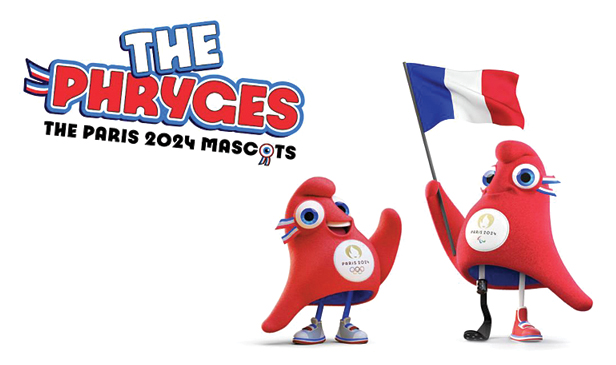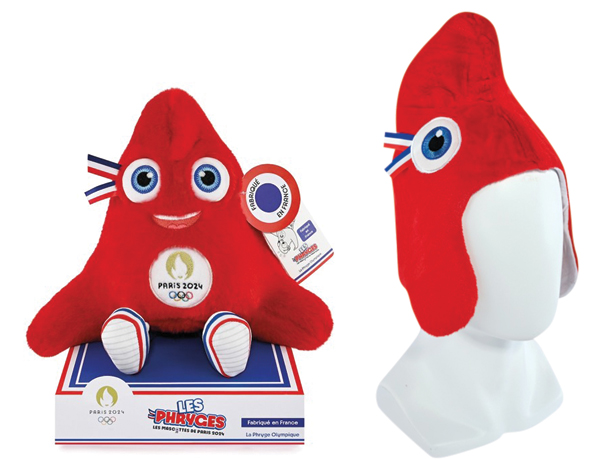CANADIAN NEWS June 25, 2024
Paris Olympics Mascot Reflects French History – and Interesting Design Choices
A Phryge? What’s a Phryge?
At first glance, the Phryges – mascots for this year’s Olympic and Paralympic Games set to begin July 26 in Paris – look like slightly floppy red triangles with eyes and legs. Perhaps birds, or slightly misshapen rockets?
Actually, they’re hats.
More specifically, Phrygian caps. These red hats were worn during the French Revolution, and they’re still seen today as a symbol of freedom and liberty.

The mascots of this year’s Olympic and Paralympic Games in Paris are a pair of Phrygian caps, a French symbol of liberty derived from associations with the revolution.
The first (unofficial) Olympic mascot became a part of the Games’ fanfare in 1968. And while the mascots are far from the largest emphasis of Olympic marketing today, they’re often brought to life in character costumes and provide the source material for a significant segment of official Olympic merchandise – particularly if the mascot is a popular one.
Leading up to and during the 2022 Winter Games in Beijing, official retailers sold more than 6.5 million plush toys of the mascot, panda Bing Dwen Dwen, and almost 70% of all licensed products sold featured the smiling mascot, according to the International Olympic Committee’s marketing report.
The selection of official Phryge merchandise available on the Olympic website includes an assortment of plush toys of both the Olympic Phryge and its Paralympic counterpart, which features a right prosthetic leg.
There’s both a regular, less expensive version of the plush and a specifically identified (and double the price) “Made in France” version. The Paris Olympic Committee received significant pushback from the country not because of the mascot’s odd appearance, but because less than 10% of the plushies would be manufactured in France when the mascot itself represents the French Revolution.
The rest of the mascot collection features the typical T-shirts, hoodies, tote bags, pins, keychains and the like – and, yes, a newly added Phrygian hat complete with bright blue eyeballs and patriotically striped eyelashes.

The official merchandise store for the 2024 Paris Olympic Games includes a selection of plush toys – usually a popular form of mascot-themed merch – as well as an actual Phryge Phrygian cap.
Most often, Olympic mascots are stylized or animated animals common in the host country, like Bing Dwen Dwen the panda or Sam from the Los Angeles 1984 Games, an Uncle Sam-ified bald eagle.
However, the Organizing Committee for the Olympic Games, responsible for selecting the mascots, sometimes takes things in a different direction. This has resulted in such lovable characters as the amorphous blob Izzy (formerly Whatizit) from the 1994 Games in Atlanta; London 2012’s Wenlock, a chunk of steel that looks like a cyclops; and the first mascot, from the 1968 Games in Grenoble, Schuss the … button with skis?
And, of course, there are the Phryges.
When the mascots are … unconventional, it often causes a lot of online pushback. Both the 1994 Atlanta and 2012 London Olympic mascots, for example, were ridiculed online, with the Guardian starting off one article about how the London Games were the “worst Olympics ever” with none other than its mascots.
While this year’s Phryges are popular among the French – they had a 75% approval rating among French citizens, according to a 2022 survey carried out when the mascots were first announced – the Olympics’ global audience might not have quite the same appreciation for their symbolism.
Here in ASI’s editorial department, confusion ran rampant about the mascot’s identity – along with a sense of burning unease.
“The idea of a sentient hat worries me,” said Theresa Hegel, ASI’s executive director of digital content.
“Is Phryge inside the hat? Is he the hat? Were they eaten by the hat? Whose eyes are those – Phryge’s or the hat’s? If he’s the hat, how am I supposed to wear it with their legs? Are those the hat’s arms, or is Phryge stuck inside trying to break out? Do they have eyelids?” Phineas Hogan, editorial staffer, asked, incredulous. “This thing is horrifying.”
Why should we care about a cute mascot? Beyond the initial visual concern – and that potential for substantial branded merch revenue – there’s one other important (and not at all spurious) correlation with mascot cuteness: the number of Team USA Olympic medals.
According to the rating system established by the ASI editorial department, the cuter the mascot, the more medals Team USA earns at the Games.
Based on this extremely official data gathering in the ASI office, Phryge is actually quite cute for a summer mascot, despite our misgivings about its unusual appearance – so we should do just fine at this year’s Games.

